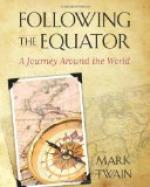The whole narrow, hilly belt of the Pacific side of New South Wales has the climate of its capital—a mean winter temperature of 54 deg. and a mean summer one of 71 deg. It is a climate which cannot be improved upon for healthfulness. But the experts say that 90 deg. in New South Wales is harder to bear than 112 deg. in the neighboring colony of Victoria, because the atmosphere of the former is humid, and of the latter dry. The mean temperature of the southernmost point of New South Wales is the same as that of Nice—60 deg.—yet Nice is further from the equator by 460 miles than is the former.
But Nature is always stingy of perfect climates; stingier in the case of Australia than usual. Apparently this vast continent has a really good climate nowhere but around the edges.
If we look at a map of the world we are surprised to see how big Australia is. It is about two-thirds as large as the United States was before we added Alaska.
But where as one finds a sufficiently good climate and fertile land almost everywhere in the United States, it seems settled that inside of the Australian border-belt one finds many deserts and in spots a climate which nothing can stand except a few of the hardier kinds of rocks. In effect, Australia is as yet unoccupied. If you take a map of the United States and leave the Atlantic sea-board States in their places; also the fringe of Southern States from Florida west to the Mouth of the Mississippi; also a narrow, inhabited streak up the Mississippi half-way to its head waters; also a narrow, inhabited border along the Pacific coast: then take a brushful of paint and obliterate the whole remaining mighty stretch of country that lies between the Atlantic States and the Pacific-coast strip, your map will look like the latest map of Australia.
This stupendous blank is hot, not to say torrid; a part of it is fertile, the rest is desert; it is not liberally watered; it has no towns. One has only to cross the mountains of New South Wales and descend into the westward-lying regions to find that he has left the choice climate behind him, and found a new one of a quite different character. In fact, he would not know by the thermometer that he was not in the blistering Plains of India. Captain Sturt, the great explorer, gives us a sample of the heat.




